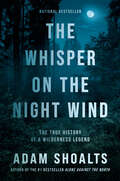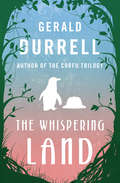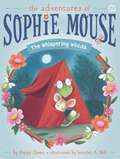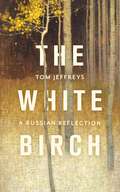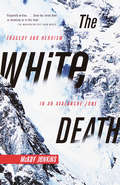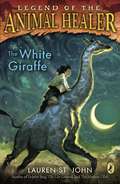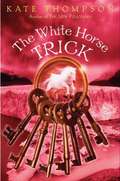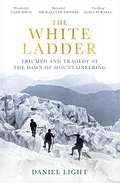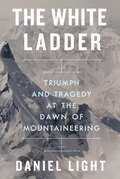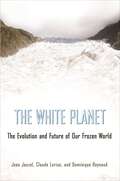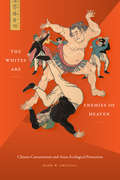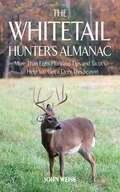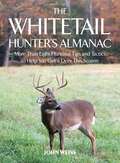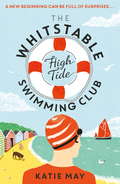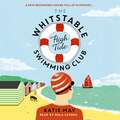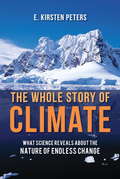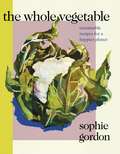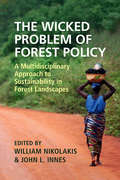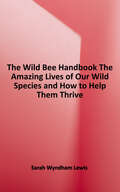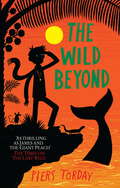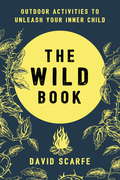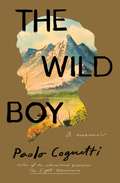- Table View
- List View
The Whisper on the Night Wind: The True History of a Wilderness Legend
by Adam ShoaltsSpellbinding adventure from Canada's most beloved modern-day explorer.Traverspine is not a place you will find on most maps. A century ago, it stood near the foothills of the remote Mealy Mountains in central Labrador. Today it is an abandoned ghost town, almost all trace of it swallowed up by dark spruce woods that cloak millions of acres.In the early 1900s, this isolated little settlement was the scene of an extraordinary haunting by large creatures none could identify. Strange tracks were found in the woods. Unearthly cries were heard in the night. Sled dogs went missing. Children reported being stalked by a terrifying grinning animal. Families slept with cabin doors barred and axes and guns at their bedsides.Tales of things that "go bump in the night" are part of the folklore of the wilderness, told and retold around countless campfires down through the ages. Most are easily dismissed by skeptics. But what happened at Traverspine a hundred years ago was different. The eye-witness accounts were detailed, and those who reported them included no less than three medical doctors and a wildlife biologist.Something really did emerge from the wilderness to haunt the little settlement of Traverspine. Adam Shoalts, decorated modern-day explorer and an expert on wilderness folklore, picks up the trail from a century ago and sets off into the Labrador wild to investigate the tale. It is a spine-tingling adventure, straight from a land steeped in legends and lore, where Vikings wandered a thousand years ago and wolves and bears still roam free.In delving into the dark corners of Canada's wild, The Whisper on the Night Wind combines folklore, history, and adventure into a fascinating saga of exploration.
The Whispering Land: A Zoo In My Luggage, The Whispering Land, And Menagerie Manor (The Zoo Memoirs #2)
by Gerald DurrellNaturalist Gerald Durrell recalls his expedition to South America to find exotic animals in this follow-up to A Zoo in My Luggage. After bringing multiple species of African animals back to the Channel Island of Jersey to populate their new zoo, British naturalist Gerald Durrell and his wife followed their passion for wildlife preservation on a journey to South America. With a team of helpers, they spent eight months on safari searching for exotic specimens. Through windswept Patagonian shores and tropical forests in the Argentine, from ocelots to penguins, fur seals to parrots to pumas, the author who inspired the public television drama The Durrells in Corfu captures the landscape and its inhabitants with his signature charm and humor. Filled with adventure, exploration, and the spirit of conservation, The Whispering Land is a memoir that animal lovers of all ages will enjoy. This ebook features an illustrated biography of Gerald Durrell including rare photos from the author&’s estate.
The Whispering Woods (The Adventures of Sophie Mouse #19)
by Poppy GreenSophie, Hattie, and Owen go camping only to get spooked by some whispering in the woods in this eighteenth charming book of The Adventures of Sophie Mouse!Sophie, Hattie, and Owen are so excited to go camping! They prepare by learning how to set up a tent and making sure their bags are packed! But they aren&’t prepared for the strange noises they hear while exploring their campsite. Is there someone else in the woods nearby, or is it just their imagination? As it gets dark out, and they hear the noises again, the friends decide they need to find out just what&’s going on in these whispering woods. With easy-to-read language and illustrations on almost every page, the Sophie Mouse chapter books are perfect for beginning readers!
The White Birch: A Russian Reflection
by Tom Jeffreys'It has been hand-planted by Tsarinas and felled by foresters. It has been celebrated by peasants, worshipped by pagans and painted by artists. It has self-seeded across mountains and rivers and train tracks and steppe and right through the ruined modernity of a nuclear fall-out site. And like all symbols, the story of the birch has its share of horrors (white, straight, native, pure: how could it not?). But, maybe in the end, what I'm really in search of is a birch that means nothing: stripped of symbolism, bereft of use-value . . . A birch that is simply a tree in a land that couldn't give a shit.'The birch, genus Betula, is one of the northern hemisphere's most widespread and easily recognisable trees. A pioneer species, the birch is also Russia's unofficial national emblem, and in The White Birch art critic Tom Jeffreys sets out to grapple with the riddle of Russianness through numerous journeys, encounters, histories and artworks that all share one thing in common: the humble birch tree.We visit Catherine the Great's garden follies and Tolstoy's favourite chair; walk through the Chernobyl exclusion zone and among overgrown concrete bunkers in Vladivostok; explore the world of online Russian brides and spend a drunken night in Moscow with art-activists Pussy Riot, all the time questioning the role played by Russia's vastly diverse landscapes in forming and imposing national identity. And vice-versa: how has Russia's dramatically shifting self-image informed the way its people think about nature, land and belonging?Curious, resonant and idiosyncratic, The White Birch is a unique collection of journeys into Russia and among Russian people.
The White Dawn: An Eskimo Saga
by James D. HoustonAdventure and romance when whalers are rescued by Eskimos
The White Death: Tragedy and Heroism in an Avalanche Zone
by Mckay JenkinsIn 1969, five young men from Montana set out to accomplish what no one had before: to scale the sheer north face of Mt. Cleveland, Glacier National Park's tallest mountain, in winter. Two days later tragedy struck: they were buried in an avalanche so deep that their bodies would not be discovered until the following June. The White Death is the riveting account of that fated climb and of the breathtakingly heroic rescue attempt that ensued. In the spirit of Peter Matthiessen and John McPhee, McKay Jenkins interweaves a harrowing narrative with an astonishing expanse of relevant knowledge ranging from the history of mountain climbing to the science of snow. Evocative and moving, this fascinating book is a humbling account of man at his most intrepid and nature at its most indomitable.
The White Giraffe
by Lauren St. JohnThe night Martine Allen turns eleven-years-old is the night her life changes completely. Martine's parents are killed in a fire, so she must leave her home to live on an African wildlife reserve with a grandmother she never even knew she had. When Martine arrives, she hears tales of a mythical animal living there -- a white giraffe. They say no one has ever seen the animal, but it does leave behind footprints. Her grandmother insists that the white giraffe is just a legend, but then, one stormy night, Martine looks out her bedroom window straight into the eyes of the tall silvery animal. Could it be just Martine's imagination, or is the white giraffe real? And if so, why is everyone keeping its existence a secret?
The White Horse Trick
by Kate ThompsonThe world is drowning. Freak storms and devastating hurricanes sweep across the countryside. No one has enough food or firewood-electricity is an option only for the tyrannical Commander-and then the Commander begins stealing young children away. Pup's little brother is one of the missing. Determined to save his brother, Pup confronts the Commander and finds himself "volunteered" for a special force. One that will slip through the barriers of time into a land where the sun never sets . . . just as another boy from Kinvara did long ago. With the future of both realms at stake, the fairies and humans must take drastic measures to stop the destruction. But not everyone wants the human race to survive. . . . The thrilling conclusion to the story that began in the acclaimed The New Policeman.
The White Ladder: Triumph and Tragedy at the Dawn of Mountaineering
by Daniel LightThe true story of the thrill-seekers, map-makers, soldiers, occultists, artists and porters who paved the way for modern mountaineering. &‘A beautifully written and sure-footed history of mountaineering &“before Everest&”, full of wonderful stories and spanning continents and centuries. A splendid debut.&’ Sir Ranulph Fiennes, author of Shackleton Beautiful, remote and dangerous – for generations we have looked to the mountains in awe. Yet, for most, that is where the fascination ends. For a rare few, however, the allure of the peaks proved irresistible. There are the devout Incan priests who, scaling the Andes&’ icy slopes to pay tribute to each mountain&’s &‘Great Lord&’, travelled higher than any European would for centuries. The Gurkha riflemen who joined their commanders in canvassing the Karakoram, admiring the distant summits of Broad Peak and K2 with gleeful anticipation. The tweed-clad mountaineers who made the first serious assaults on Everest, hauling yards upon yards of battered rope through the cold. Tracing the world altitude record from the ashy slopes of the sacred volcano Llullaillaco to the icy crags and crevasses of the Karakoram, Daniel Light takes a panoramic journey through the storied history of mountaineering before Everest. Joining a cast of colourful characters, The White Ladder offers an ode to mountains&’ capacity to enthral, and the fundamental human drive to climb higher and higher. *** 'Thrilling... Daniel Light delivers stories that are poetic, spiritual and astonishing in their courage and drive.' Sonia Purnell, author of A Woman of No Importance &‘Daniel Light guides the reader through a mountain-scape that stretches from the Alps to the Himalaya... with the sure footing of a serious student of climbing history, and the élan of a skilled storyteller. This is a book to curl up with on a cold dark night in a comfortable armchair before a bright fire.&’ Maurice Isserman, co-author of Fallen Giants &‘Wonderful… a massive story with an enormous cast of characters, among them some of the most compelling figures of mountaineering history.&’ Wade Davis, author of Into the Silence
The White Ladder: Triumph and Tragedy at the Dawn of Mountaineering
by Daniel LightA sweeping history of mountaineering before Everest, and the epic human quest to reach the highest places on Earth. Whether in the name of conquest, science, or the divine, humans across the centuries have had myriad reasons to climb mountains. From the smoking volcanoes of South America to the great snowy ranges of the Himalaya, The White Ladder follows a cast of extraordinary characters—conquistadors and captains, scientists and surveyors, alpinists and adventurers—up the slopes of the world’s highest peaks. A masterpiece of edge-of-your-seat narrative history, The White Ladder describes the epic rise of mountaineering’s world altitude record, a story of ever higher climbs by figures great and small of mountaineering during the nineteenth and early twentieth centuries. Daniel Light describes how climbers used revolutionary techniques to launch themselves into the most forbidding conditions. The expeditions illustrate evolutionary changes in climbing style, the advancement of high-altitude science, and the development of mountain climbing as an industry. Throughout, Light pays special attention to Incan climbers, Gurkha guides, Sherpa mountaineers, and many others who are often overlooked. He offers nuanced new perspectives on familiar characters, for example, calling out the famed female pioneer Fanny Bullock Workman for racism and for abusing her porters. He presents a complex new portrait of notorious occultist Aleister Crowley, who was at once a ruthless expedition leader, but also an innovative strategist who could read mountains and would risk everything trying to climb them. Light also makes bold new arguments about classic debates, for example, arguing that the much-maligned Jewish climber Oscar Eckenstein shaped mountaineering as we know it today. A story of innovation, invention, and determination, The White Ladder immerses readers in a fascinating historical period. With their breathtaking exploits, these climbers laid the groundwork for the historic ascents of K2 and Everest that came after—and heightened the spectacle of their dangerous sport.
The White Planet: The Evolution and Future of Our Frozen World
by Jean Jouzel Claude Lorius Dominique RaynaudA gripping journey through the icy regions of our changing planetFrom the Arctic Ocean and ice sheets of Greenland, to the glaciers of the Andes and Himalayas, to the great frozen desert of Antarctica, The White Planet takes readers on a spellbinding scientific journey through the shrinking world of ice and snow to tell the story of the expeditions and discoveries that have transformed our understanding of global climate. Written by three internationally renowned scientists at the center of many breakthroughs in ice core and climate science, this book provides an unparalleled firsthand account of how the "white planet" affects global climate—and how, in turn, global warming is changing the frozen world.Jean Jouzel, Claude Lorius, and Dominique Raynaud chronicle the daunting scientific, technical, and human hurdles that they and other scientists have had to overcome in order to unravel the mysteries of past and present climate change, as revealed by the cryosphere--the dynamic frozen regions of our planet. Scientifically impeccable, up-to-date, and accessible, The White Planet brings cutting-edge climate research to general readers through a vivid narrative. This is an essential book for anyone who wants to understand the inextricable link between climate and our planet's icy regions.
The Whites Are Enemies of Heaven: Climate Caucasianism and Asian Ecological Protection
by Mark W. DriscollIn The Whites Are Enemies of Heaven Mark W. Driscoll examines nineteenth-century Western imperialism in Asia and the devastating effects of "climate caucasianism"—the white West's pursuit of rapacious extraction at the expense of natural environments and people of color conflated with them. Drawing on an array of primary sources in Chinese, Japanese, and French, Driscoll reframes the Opium Wars as "wars for drugs" and demonstrates that these wars to unleash narco- and human traffickers kickstarted the most important event of the Anthropocene: the military substitution of Qing China's world-leading carbon-neutral economy for an unsustainable Anglo-American capitalism powered by coal. Driscoll also reveals how subaltern actors, including outlaw societies and dispossessed samurai groups, became ecological protectors, defending their locales while driving decolonization in Japan and overthrowing a millennia of dynastic rule in China. Driscoll contends that the methods of these protectors resonate with contemporary Indigenous-led movements for environmental justice.
The Whitetail Hunter's Almanac: More Than 800 Tips and Tactics to Help You Get a D (Lyons Press Ser.)
by John WeissTo take the most impressive whitetail bucks, and to bring them in consistently, a hunter has to know his weapons, the woods, and most of all, his quarry. Now, with The Whitetail Hunter's Almanac at your side, you too can hunt with the strategies and practical wisdom that master hunter John Weiss has learned during his thirty-plus years on the field. Drawing on years of insider research, data studies, and personal experience, Weiss reveals the never-fail methods to making your shots count.Weiss's expert whitetail hunting secrets include:Little-known facts about whitetailsThe perfect places to set up blinds and standsEffective ways to use deer scentsDisappearing with camouflageHunting with a rifle, shogun, or bowAnd much more!With careful instructions and over two hundred photographs to bring the hunt to you, The Whitetail Hunter's Almanac is the must-have reference to make you a better tracker, a craftier woodsman, and a more consistently successful whitetail hunter. If you love the thrill of taking down a majestic buck, The Whitetail Hunter's Almanac is the guide for you!
The Whitetail Hunter's Almanac: More Than 800 Tips and Tactics to Help You Get a Deer This Season (Lyons Press Ser.)
by John Weiss Peter FiducciaTo take the most impressive whitetail bucks, and to bring them in consistently, a hunter has to know his weapons, the woods and, most of all, his quarry. Now, with The Whitetail Hunter’s Almanac at your side, you too can hunt with the strategies and practical wisdom that master hunter John Weiss has learned during his thirty-plus years on the field. Drawing on years of insider research, data studies, and personal experience, Weiss reveals the never-fail methods to making your shots count.Weiss’s expert whitetail hunting secrets include: Little-known facts about whitetails The perfect places to set up blinds and stands Effective ways to use deer scents How to disappear with camouflage Hunting with a rifle, shotgun, or bow And much more!With careful instructions and more than two hundred photographs to bring the hunt to you, The Whitetail Hunter’s Almanac is the must-have reference to make you a more efficient tracker, woodsman, and consistently successful whitetail hunter. If you love the thrill of outwitting a big buck, The Whitetail Hunter’s Almanac is the guide for you!
The Whitstable High Tide Swimming Club: A feel-good novel about second chances and new beginnings
by Katie May'An uplifting story of friendship and second chances. Loved it.' Amazon reviewer, 5 starsSearching for friendship? You'll find it at The Whitstable High Tide Swimming Club...When Deb (ageing bikini, sunglasses) and Maisie (black wetsuit, swimming shoes, goggles) keep meeting on Reeves Beach, they strike up an unlikely friendship based on their love of swimming and their recent divorces. Soon, they are joined by other high tide swimmers, each with a crisis of their own to weather. Ann, a bossy organiser, is caring for her elderly mother at home; Julie has somehow (although she's not quite sure how) managed to produce three children under school age; and Chloe, a bright, brittle girl of fifteen, finds calmness in the water, and Quiet, anxious Bill is soon welcomed into the heart of the club. When the swimmers discover plans for their beach to be paved over for a leisure complex, together they are determined to make a stand, and to prove that the beach is more than just a place to swim - it is the heart of the community.The perfect summertime read for fans of Veronica Henry, Cathy Bramley, Lucy Diamond and Carole Matthews ***** Readers are loving The Whitstable High Tide Swimming Club 'Laugh-out-loud moments and dollops of heart-warming community spirit' - Lancashire Evening Post 'A beautiful setting, wonderful characters, and a great story.' 'This book really is about the strong power of female friendship and I loved every moment of it.' 'Uplifting and fun story about resilient women.''Gorgeous!'
The Whitstable High Tide Swimming Club: A feel-good novel all about female friendship and community
by Katie MayDive into THE WHITSTABLE HIGH TIDE SWIMMING CLUB - the irresistible, feel-good novel from Katherine May. Join Debs and Maisie and the high tide swimmers as they make waves in life, love and friendship. Only the truly devoted manage to swim every day at Whitstable, because the sea's only deep enough at high tide. So when Deb (ageing bikini, sunglasses) and Maisie (black wetsuit, swimming shoes, goggles) keep meeting on Reeves Beach, they strike up an unlikely friendship based on their love of swimming and their recent divorces. They swim early in the morning and late at night; through sea-fogs, rain and glorious sunny days. Soon, they are joined by other high tide swimmers, each with a crisis of their own to weather. Ann, a bossy organiser, is caring for her elderly mother at home; Julie has somehow (although she's not quite sure how) managed to produce three children under school age; and Chloe, a bright, brittle girl of fifteen, finds calmness in the water. Quiet, anxious Bill is initially thought to be a peeping Tom, before being welcomed into the heart of the club.When the swimmers discover plans for their beach to be paved over for a leisure complex, they find a higher purpose that bonds them together, and exposes their fragile worlds to public scrutiny.Originally published as a three-part serial. This is the complete story in one package.THE WHITSTABLE HIGH TIDE SWIMMING CLUB is a book about the power of female friendship, that never loses sight of the complicated truths behind the lives of women who - from the outside - seem to take everything in their stride. It's also a song to the author's home town of Whitstable, where the sea is smooth, the shingle is painful on bare feet, and the air is full of possibilities.Read by Rula Lenska(p) Orion Publishing Group 2018
The Whole Story of Climate
by E. Kirsten PetersAccessible and engagingly written, this book is essential reading for anyone looking to understand one of our most important contemporary debates. In the publicity surrounding global warming, climate scientists are usually the experts consulted by the media. We rarely hear from geologists, who for almost two hundred years have been studying the history of Earth's dramatic and repeated climate revolutions, as revealed in the evidence of rocks and landscapes. This book, written by a geologist, describes the important contributions that geology has made to our understanding of climate change. What emerges is a much more complex and nuanced picture than is usually presented. While the average person often gets the impression that the Earth's climate would be essentially stable if it weren't for the deleterious effects of greenhouse gases, in fact the history of the earth over many millennia reveals a constantly changing climate. As the author explains, several long cold eras have been punctuated by shorter warm periods. The most recent of these warm spells, the one in which we are now living, started ten thousand years ago; based on previous patterns, we should be about due for the return of another frigid epoch. Some scientists even think that the warming of the planet caused by man-made greenhouse gasses tied to agriculture in the past few thousand years may have held off the next ice age. Though this may be possible, much remains uncertain. But what is clearly known is that major climate shifts can be appallingly rapid-occurring over as little as twenty or thirty years. One danger of dumping greenhouse gases into the atmosphere is that they may increase the chance that this "climate switch" will be thrown, with catastrophic effects on worldwide agriculture. Besides her discussion of climate, the author includes chapters on how early naturalists pieced together the complicated geological history of Earth, and she teaches the reader how to interpret the evidence of rock formations and landscape patterns all around us.
The Whole Vegetable: Sustainable and delicious vegan recipes
by Sophie GordonDiscover wholesome, sustainable and plant-based dishes in this essential cookbook, perfect for anyone looking to reduce their waste this year!'Hearty, healthy, flavour-packed dishes' MAIL ON SUNDAY'A uniquely sustainable and delicious approach to modern plant-based cooking' VOGUE'The Whole Vegetable blew me away . . . Full of inventive waste-free recipes' Tom Hunt, GUARDIAN_________Have you ever wondered how to make your diet truly eco-conscious?In this beautiful plant-based cookbook, over 130 creative, delicious, planet-friendly recipes put vegetables at the very centre of the table. Embracing often-discarded parts such as leaves, stalks, tops, flowers, seeds and even peelings, this is cooking at its most sustainable.In The Whole Vegetable, Sophie Gordon shows us how to:- Cook with every part of every vegetable- Reduce waste in your cooking- Reinvent your leftovers- Eat with the seasonsFrom Cauliflower Carbonara, Broccoli Pesto and Chunky Pumpkin Tacos, to Cherry Breakfast Crumble, Maple-Roasted Pears and Apple & Walnut Danish Buns, The Whole Vegetable is packed with thoughtful recipes for every season.Most of all, it will ensure that nothing in your kitchen goes to waste._________'Creative, delicious, planet-friendly recipes . . . Teaches you how to put those often discarded parts of fruit and veg to good (and tasty) use' Women's Health'Wow, Sophie Gordon's . . . The Whole Vegetable blew me away. I wonder if she is the next Anna Jones. A seasonal, plant-centric, whole food recipe book without ultra-processed vegan ingredients. The recipes are super-inventive and importantly waste free!' Eco-Chef Tom Hunt'The Whole Vegetable heroes plant-based cookery, with recipes that also help reduce food waste in the kitchen and improve sustainable living. A worthwhile read' Good Housekeeping
The Wicked Problem of Forest Policy: A Multidisciplinary Approach to Sustainability in Forest Landscapes
by John L. Innes William NikolakisForests play an important role in resolving global challenges such as sustainable development, climate change, biodiversity loss, and food and water security. Stopping deforestation is crucial for the future of our planet. Global efforts to curb deforestation, have been partially successful, but have largely fallen short. At the same time, national level efforts to support human development, reflected in the United Nations (UN) Sustainable Development Goals, aim to increase the welfare and wellbeing of populations living in poverty. Meeting these development goals will inevitably have crosscutting effects on initiatives to address deforestation. In balancing these goals, policy makers are confronted with wicked problems – or problems where there are moral considerations and where limited information is available for policy makers. This book is focused on how wicked forest policy problems have been, and can be, addressed.
The Wild Bee Handbook: The Amazing Lives of Our Wild Species and How to Help Them Thrive
by Sarah Wyndham-LewisThere are over 20,000 species of bees worldwide, of which just seven species are honeybees. In the US alone, there are over 4,000 species of bee, whereas Europe only have nearly 2,000 bee species and the UK has 275.The Wild Bee Handbook is a practical, illustrated guide that will introduce you to the common wild bees you might find in your garden. Through a handy directory, learn how vital wild bees are to the ecosystem and discover how we can garden to offer them the food and habitat they need. This book is an essential resource for anyone interested in biodiversity and sustainable gardening, featuring sections on container gardening, the no-dig method, how to maintain soil health, the principles for rewilding and wildflower gardening for success - it doesn't matter how big or small your space, you can still garden to support wild bees. The Wild Bee Handbook is a celebration of the wild pollinators and a beautifully illustrated, informative guide that will equip you to create a green space to help them thrive. Join the wave of change and learn how to grow sustainability.
The Wild Beyond: Book 3 (The Last Wild Trilogy #3)
by Piers TordayFROM THE WINNER OF THE GUARDIAN CHILDREN'S FICTION PRIZE A thrilling animal adventure for fans of Roald Dahl, David Walliams and Katherine RundellThis is the story of a boy named Kester. He has rescued the last wild animals in the world, and saved his capital city from destruction. But now he must face his greatest challenge yet, because:1. The only blue whale on the planet has brought news from across the ocean2. A mysterious steel dome has risen from the Four Towers3. Out there, somewhere, a brave mouse holds the key to the future...
The Wild Book: Outdoor Activities to Unleash Your Inner Child
by David ScarfeIn a world in which we're never far from our phones or tablets, computers or consoles, we can often be blind to the joy that can be found in the great outdoors. We're building worlds in Minecraft when we could be building a raft; we're watching the latest Netflix show when we could be gazing at the stars; we're idly scrolling on social media when we could be strolling through woodlands; we're internet shopping when we could be panning for gold.Our phones may be smarter, but our experiences have shrunk down to the size of the screens in front of our eyes. The Wild Book is here to re-acquaint us with the wonders that await in the outside world. Beautifully produced, full of fun, easy-to-do games and activities - including how to make sloe gin, climb trees, build a fire, identify different cloud formations and make a shelter - this is the ultimate book to unleash your inner child.
The Wild Book: Outdoor Activities to Unleash Your Inner Child
by David ScarfeIn a world in which we're never far from our phones or tablets, computers or consoles, we can often be blind to the joy that can be found in the great outdoors. We're building worlds in Minecraft when we could be building a raft; we're watching the latest Netflix show when we could be gazing at the stars; we're idly scrolling on social media when we could be strolling through woodlands; we're internet shopping when we could be panning for gold.Our phones may be smarter, but our experiences have shrunk down to the size of the screens in front of our eyes. The Wild Book is here to re-acquaint us with the wonders that await in the outside world. Beautifully produced, full of fun, easy-to-do games and activities - including how to make sloe gin, climb trees, build a fire, identify different cloud formations and make a shelter - this is the ultimate book to unleash your inner child.
The Wild Boy: A Memoir
by Paolo CognettiA young man escapes his painful past by retreating to the rustic comfort of the Italian Alps in this gorgeously wrought memoir from the internationally bestselling author of the “exquisite” (Annie Proulx) novel The Eight Mountains.When life in the city becomes too overwhelming for Paolo, he decides to take refuge high in the Italian mountains. Returning to the breathtaking Valle d’Aosta—known for its snowcapped mountain peaks—after a decade’s absence, he rediscovers a simpler life and develops deep human connections with two neighbors. In this stunning landscape, he begins to take stock of his life and consider what he truly values. With lyrical and evocative prose, The Wild Boy is a testament to the power of the natural world, the necessity of an ever-questioning mind, and the resilience of the human spirit.
